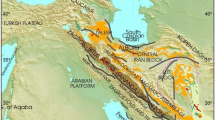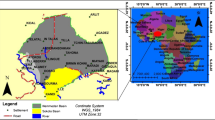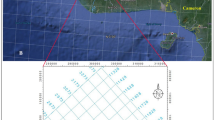Abstract
The Bida and Anambra Basins are major inland sedimentary basins located in the central and southern part of Nigeria with possible hydrocarbon potential but lack exploratory data. The present study aims at providing base line information on the thermal regime of the sedimentary basins, which would significantly contribute to its hydrocarbon prospect, investment opportunity and exploitation. The spectral analysis of the aeromagnetic anomaly data from the southern Bida Basin, northern Anambra Basin and adjacent basement complex terrain reveals the Curie point depth (CPD), geothermal gradient and heat flow in the region. The data reveals a CPD that varies between 19 and 30 km while the geothermal gradient is from 23 to more than 44 °C/km with heat flow values ranging from 50 to 109 mW/m2 in the southern Bida Basin. In the northern Anambra Basin, the CPD values range from 6.8 to 20 km and the heat flow values vary between 59 mWm2 and 109 mWm2, with a localized shallow CPD value of less than 6.8 km and associated high heat flow of 109 mWm2 in the central part of the basin. The delineated thermal patterns in the Bida and Anambra Basins are interpreted to be associated with the intrusions and the presence of deep-seated rift. The interpretation of the aeromagnetic data shows good agreement with the land surface temperature obtained from remote sensing data of the study area. The distribution of heat patterns in the southern Bida and northern Anambra Basins have implications for geothermal, source rock maturation and hydrocarbon generation evaluation of the basins.












Similar content being viewed by others
Data availability
The topographic data (digital elevation model) and Landsat-8 data used for this study is publicly accessible and was downloaded from the US Geological Survey (USGS) website, available at https://earthexplorer.usgs.gov/. The aeromagnetic data have government restriction and is not publicly available, but the aeromagnetic data can be acquired from the Nigerian Geological Survey Agency.
References
Abdel-Fattah, M. I., Shendi, E. H., Kaiser, M. F., & Abuzied, S. M. (2021). Unveiling geothermal potential sites along Gulf of Suez (Egypt) using an integrated geoscience approach. Terra Nova, 33(3), 306–319. https://doi.org/10.1111/ter.12516
Adeleye, D. R., Dessauvagie, T. F. J. (1972). Stratigraphy of the Mid-Niger Emabyment near Bida, Nigeria. In T. J. F. Dessauvagie & A. J. Whiteman (Eds.), Proceedings of the Conference on African Geology (pp. 181–186). Ibadan: Ibadan University Press.
Adeleye, D. R. (1976). The Geology of the Middle Niger Basin. (C. A. Kogbe, Ed.) (Geology of Nigeria.). Lagos: Elizabethan Publishing Company.
Adeleye, D. R. (1989). The Geology of the Middle Niger Basin. (C.A. Kogbe, Ed.) (2nd ed.). Lagos: Elizabethan Publishing Co.
Adeleye, D. R. (1973). Origin of ironstones, an example from the middle Niger Valley, Nigeria. SEPM Journal of Sedimentary Research. https://doi.org/10.1306/74D7284C-2B21-11D7-8648000102C1865D
Adeleye, D. R. (1974). Sedimentology of the fluvial Bida Sandstone (Cretaceous), Nigeria. Sedimentary Geology, 12(1), 1–24. https://doi.org/10.1016/0037-0738(74)90013-X
Adepoju, S. A., Ojo, O. J., Akande, S. O., & Sreenivas, B. (2020). Provenance of the Campanian-Maastrichtian Sandstone, Northern Bida Basin: Evidence from facies analysis, detrital zircon morphology and whole-rock geochemistry. NAPE Bulletin, 29, 59–81.
Agemar, T., Schellschmidt, R., & Schulz, R. (2012). Subsurface temperature distribution in Germany. Geothermics, 44, 65–77. https://doi.org/10.1016/j.geothermics.2012.07.002
Ajibade, A. C., Woakes, M., Rahaman, M. A. (2011). Proterozoic Crustal Development in the Pan-African Regime of Nigeria (Vol. 17). American Geophysical Union (AGU). https://doi.org/10.1029/GD017P0259
Akande, S. O., Ogunmoyero, I. B., Petersen, H. I., & Nytoft, H. P. (2007). Source rock evaluation of coals from the Lower Maastrichtian Mamu Formation, SE Nigeria. Journal of Petroleum Geology, 30(4), 303–324. https://doi.org/10.1111/j.1747-5457.2007.00303.x
Akande, S. O., Ojo, O. J., Erdtmann, B. D., & Hetenyi, M. (2005). Paleoenvironments, organic petrology and Rock-Eval studies on source rock facies of the Lower Maastrichtian Patti Formation, southern Bida Basin, Nigeria. Journal of African Earth Sciences, 41(5), 394–406. https://doi.org/10.1016/j.jafrearsci.2005.07.006
Braide, S. P. (1990). Petroleum geology of the Southern Bida Basin, Nigeria. In AAPG Bulletin.
Braide, S. P. (1992). Syntectonic fluvial sedimentation in the central Bida Basin. Journal of Mining and Geology, 28, 55–64.
Dada, S. S. (2008). Proterozoic evolution of the Nigeria-Boborema province. Geological Society, London, Special Publications, 294(1), 121–136. https://doi.org/10.1144/SP294.7
Dziadek, R., Ferraccioli, F., & Gohl, K. (2021). High geothermal heat flow beneath Thwaites Glacier in West Antarctica inferred from aeromagnetic data. Communications Earth & Environment, 2(1), 162. https://doi.org/10.1038/s43247-021-00242-3
Ebbing, J., Gernigon, L., Pascal, C., Olesen, O., & Osmundsen, P. T. (2009). A discussion of structural and thermal control of magnetic anomalies on the mid-Norwegian margin. Geophysical Prospecting, 57(4), 665–681. https://doi.org/10.1111/j.1365-2478.2009.00800.x
Eppelbaum, L., Kutasov, I., Pilchin, A. (2014). Applied Geothermics. Berlin, Heidelberg: Springer Berlin Heidelberg. https://doi.org/10.1007/978-3-642-34023-9
Hussein, M., Mickus, K., & Serpa, L. F. (2013). Curie point depth estimates from aeromagnetic data from death valley and surrounding regions. California. Pure and Applied Geophysics, 170(4), 617–632. https://doi.org/10.1007/s00024-012-0557-6
Ibrahim, A., Saada, S. A., Mickus, K., Abdelrahman, K., & Khedr, F. I. (2022). Comparative study of estimating the Curie point depth and heat flow using potential magnetic data. Open Geosciences, 14(1), 462–480. https://doi.org/10.1515/geo-2022-0378
Ingo, S., Leandra, M. W., Annette, E. G., Hans, G. M., Claus-Dieter, J. H. (2021). Geothermal Reservoir Analogues on a Continental Scale: Western Canadian Sedimentary Basin versus Northern Alpine Molasse Basin. In World Geothermal Congress 2020+1. Reykjavik.
Kelemework, Y., Fedi, M., & Milano, M. (2021). A review of spectral analysis of magnetic data for depth estimation. Geophysics, 86(6), J33–J58. https://doi.org/10.1190/geo2020-0268.1
Kogbe, C. A., Ajakaiye, D. E., & Matheis, G. (1983). Confirmation of a rift structure along the Mid-Niger Valley, Nigeria. Journal of African Earth Sciences (1983), 1(2), 127–131. https://doi.org/10.1016/0899-5362(83)90004-0
Leseane, K., Atekwana, E. A., Mickus, K. L., Abdelsalam, M. G., Shemang, E. M., & Atekwana, E. A. (2015). Thermal perturbations beneath the incipient Okavango Rift Zone, northwest Botswana. Journal of Geophysical Research: Solid Earth, 120(2), 1210–1228. https://doi.org/10.1002/2014JB011029
Lowe, M., Mather, B., Green, C., Jordan, T. A., Ebbing, J., & Larter, R. (2023). Anomalously high heat flow regions beneath the transantarctic mountains and wilkes subglacial Basin in East Antarctica Inferred from Curie Depth. Journal of Geophysical Research: Solid Earth. https://doi.org/10.1029/2022JB025423
Mather, B., & Fullea, J. (2019). Constraining the geotherm beneath the British Isles from Bayesian inversion of Curie depth: Integrated modelling of magnetic, geothermal, and seismic data. Solid Earth, 10(3), 839–850. https://doi.org/10.5194/se-10-839-2019
McCay, A., Harley, T., Younger, P., Sanderson, D., & Cresswell, A. (2014). Gamma-ray spectrometry in geothermal exploration: State of the art techniques. Energies, 7(8), 4757–4780. https://doi.org/10.3390/en7084757
Melouah, O., Eldosouky, A. M., & Ebong, E. D. (2021). Crustal architecture, heat transfer modes and geothermal energy potentials of the Algerian Triassic provinces. Geothermics, 96, 102211. https://doi.org/10.1016/j.geothermics.2021.102211
Mickus, K., & Hussein, M. (2016). Curie Depth analysis of the Salton Sea Region, Southern California. Pure and Applied Geophysics, 173(2), 537–554. https://doi.org/10.1007/s00024-015-1100-3
Mohamed, A., & Deep, M. (2021). Depth to the bottom of the magnetic layer, crustal thickness, and heat flow in Africa: Inferences from gravity and magnetic data. Journal of African Earth Sciences, 179, 104204. https://doi.org/10.1016/j.jafrearsci.2021.104204
Mohamed, A., Deep, M., Abdelrahman, K., & Abdelrady, A. (2022). Geometry of the Magma Chamber and Curie point depth beneath Hawaii Island: Inferences from magnetic and gravity data. Frontiers in Earth Science. https://doi.org/10.3389/feart.2022.847984
NGSA. Geological map of Nigeria (2020). Nigerian Geological Survey Agency.
NGSA. Litho-structural map of Nigeria (2023). Nigerian Geological Survey Agency.
Nwankwo, L. I., & Sunday, A. J. (2017). Regional estimation of Curie-point depths and succeeding geothermal parameters from recently acquired high-resolution aeromagnetic data of the entire Bida Basin, north-central Nigeria. Geothermal Energy Science, 5(1), 1–9. https://doi.org/10.5194/gtes-5-1-2017
Obaje, N. G. (2009b). The Mid-Niger (Bida) Basin (pp. 91–101). https://doi.org/10.1007/978-3-540-92685-6_8
Obaje, N. G. (2009a). Geology and Mineral Resources of Nigeria (Vol. 120). Berlin, Heidelberg: Springer Berlin Heidelberg. https://doi.org/10.1007/978-3-540-92685-6
Ocheli, A., Okoro, A. U., Ogbe, O. B., & Aigbadon, G. O. (2018). Granulometric and pebble morphometric applications to Benin Flank sediments in western Anambra Basin, Nigeria: Proxies for paleoenvironmental reconstruction. Environmental Monitoring and Assessment, 190(5), 286. https://doi.org/10.1007/s10661-018-6637-z
Odumodu, C. F. R., & Mode, A. W. (2016). Geothermal gradients and heat flow variations in parts of the eastern Niger delta, Nigeria. Journal of the Geological Society of India, 88(1), 107–118. https://doi.org/10.1007/s12594-016-0463-0
Ojo, S. B., Ajakaiye, D. E. (1976). Preliminary interpretation of gravity measurements in the Middle Niger Basin area Nigeria. (C.A. Kogbe, Ed.) (Geology of Nigeria). Lagos: Elizabethan.
Ojo, S. B., Ajakaiye, D. E. (1989). Preliminary Interpretation of gravity measurements in the middle Niger Basin area, Nigeria. (C.A. Kogbe, Ed.) (2nd edition, Vol. Geology of Nigeria). Lagos: Elizabethan Publishing Company.
Ojo, S. B. (1990). Origin of a major aeromagnetic anomaly in the Middle Niger Basin, Nigeria. Tectonophysics, 185(1–2), 153–162. https://doi.org/10.1016/0040-1951(90)90410-A
Ojo, O. J., & Akande, S. O. (2009). Sedimentology and depositional environments of the Maastrichtian Patti formation, southeastern Bida Basin. Nigeria. Cretaceous Research, 30(6), 1415–1425. https://doi.org/10.1016/j.cretres.2009.08.006
Ojo, O. J., & Akande, S. O. (2013). Petrographic facies, provenance and paleoenvironments of the lokoja formation, Southern Bida Basin. Nigeria. Journal of Mining and Geology, 49(2), 93–109.
Ojo, O. J., Jimoh, A. Y., Umelo, J. C., & Akande, S. O. (2020). Organic geochemical and palynological studies of the Maastrichtian source rock intervals in Bida Basin, Nigeria: Implications for hydrocarbon prospectivity. Journal of Petroleum Exploration and Production Technology, 10(8), 3191–3206. https://doi.org/10.1007/s13202-020-00989-z
Ojo, O. J., Adepoju, S. A., Awe, A., & Adeoye, M. O. (2021a). Mineralogy and geochemistry of the sandstone facies of Campanian Lokoja formation in the Southern Bida basin, Nigeria: Implications for provenance and weathering history. Heliyon, 7(12), e08564. https://doi.org/10.1016/j.heliyon.2021.e08564
Ojo, O. J., Bamidele, T. E., Adepoju, S. A., & Akande, S. O. (2021b). Genesis and paleoenvironmental analysis of the ironstone facies of the Maastrichtian Patti formation, Bida Basin, Nigeria. Journal of African Earth Sciences, 174, 104058. https://doi.org/10.1016/j.jafrearsci.2020.104058
Okubo, Y., Graf, R. J., Hansen, R. O., Ogawa, K., & Tsu, H. (1985). Curie point depths of the Island of Kyushu and surrounding areas, Japan. Geophysics, 50(3), 481–494. https://doi.org/10.1190/1.1441926
Pamuk, E., & Özsöz, İ. (2022). Estimation of Curie-point depths and heat flow from spectral analysis of EMAG2 magnetic data in Cyprus Island. Annals of Geophysics. https://doi.org/10.4401/ag-8741
Quintero, W., Campos-Enríquez, O., & Hernández, O. (2019). Curie point depth, thermal gradient, and heat flow in the Colombian Caribbean (northwestern South America). Geothermal Energy, 7(1), 16. https://doi.org/10.1186/s40517-019-0132-9
Ravat, D., Pignatelli, A., Nicolosi, I., & Chiappini, M. (2007). A study of spectral methods of estimating the depth to the bottom of magnetic sources from near-surface magnetic anomaly data. Geophysical Journal International, 169(2), 421–434. https://doi.org/10.1111/j.1365-246X.2007.03305.x
Salawu, N. B., Fatoba, J. O., Adebiyi, L. S., Ajadi, J., Saleh, A., & Dada, S. S. (2020). Aeromagnetic and remote sensing evidence for structural framework of the middle Niger and Sokoto basins, Nigeria. Physics of the Earth and Planetary Interiors. https://doi.org/10.1016/j.pepi.2020.106593
Salawu, N. B., Dada, S. S., Fatoba, J. O., Ojo, O. J., Adebiyi, L. S., Sunday, A. J., & Abdulraheem, T. Y. (2021a). Structural architecture of the Middle Niger Basin, Nigeria based on aeromagnetic data: An example of a non-volcanic basin. Heliyon. https://doi.org/10.1016/j.heliyon.2021.e07205
Salawu, N. B., Fatoba, J. O., Adebiyi, L. S., Eluwole, A. B., Olasunkanmi, N. K., Orosun, M. M., & Dada, S. S. (2021b). Structural geometry of Ikogosi warm spring, southwestern Nigeria: Evidence from aeromagnetic and remote sensing interpretation. Geomechanics and Geophysics for Geo-Energy and Geo-Resources. https://doi.org/10.1007/s40948-021-00224-x
Salawu, N. B., Eluwole, A. B., Fajana, A. O., Orosun, M. M., Adebiyi, L. S., & Salawu, J. O. (2023). New perspective on the geothermal potential of Wikki Warm Spring, Northeastern Nigeria, from remote sensing and radiometric data. Acta Geophysica. https://doi.org/10.1007/s11600-023-01098-1
Salawu, N. B., Omosanya, K. O. L., & Fournier, D. (2024). The Middle Niger Basin in Nigeria has a rift origin, as revealed by the inversion and modeling of gravity and magnetic data. Earth and Space Science. https://doi.org/10.1029/2023EA003025
Sobh, M., Gerhards, C., Fadel, I., & Götze, H.-J. (2021). Map** the thermal structure of Southern Africa from Curie depth estimates based on wavelet analysis of magnetic data with uncertainties. Geochemistry, Geophysics, Geosystems,. https://doi.org/10.1029/2021GC010041
Springer, M. (1999). Interpretation of heat-flow density in the Central Andes. Tectonophysics, 306(3–4), 377–395. https://doi.org/10.1016/S0040-1951(99)00067-0
Tanaka, A., Okubo, Y., & Matsubayashi, O. (1999). Curie point depth based on spectrum analysis of the magnetic anomaly data in East and Southeast Asia. Tectonophysics, 306(3–4), 461–470. https://doi.org/10.1016/S0040-1951(99)00072-4
Whiteman, A. (1982). Nigeria: Its Petroleum Geology, Resources and Potential. Springer Netherlands. https://doi.org/10.1007/978-94-009-7361-9
Acknowledgements
This study is with the framework of larger ongoing research on the stratigraphy and hydrocarbon prospectivity of the Bida Basin. The authors gratefully acknowledged the TETFund National Research Fund support for this project.
Funding
The authors declare that no funds, grants, or other support were received during the preparation of this manuscript.
Author information
Authors and Affiliations
Contributions
All authors contributed to the study conception and design. Data analysis and interpretation were performed by Naheem Banji Salawu. The manuscript was written by Naheem Banji Salawu and all authors commented on the manuscript. All authors read and approved the manuscript. Prof. Olusola Johnson Ojo was involved in the data interpretation and discussion of the results.
Corresponding author
Ethics declarations
Conflict of Interest
The authors have no relevant financial or non-financial interests to disclose.
Additional information
Publisher's Note
Springer Nature remains neutral with regard to jurisdictional claims in published maps and institutional affiliations.
Rights and permissions
Springer Nature or its licensor (e.g. a society or other partner) holds exclusive rights to this article under a publishing agreement with the author(s) or other rightsholder(s); author self-archiving of the accepted manuscript version of this article is solely governed by the terms of such publishing agreement and applicable law.
About this article
Cite this article
Salawu, N.B., Ojo, O.J. Evaluation of the Thermal Regime of the Southern Bida and Northern Anambra Basins, Nigeria: Insights from Aeromagnetic and Remote Sensing Data. Pure Appl. Geophys. (2024). https://doi.org/10.1007/s00024-024-03516-x
Received:
Revised:
Accepted:
Published:
DOI: https://doi.org/10.1007/s00024-024-03516-x




